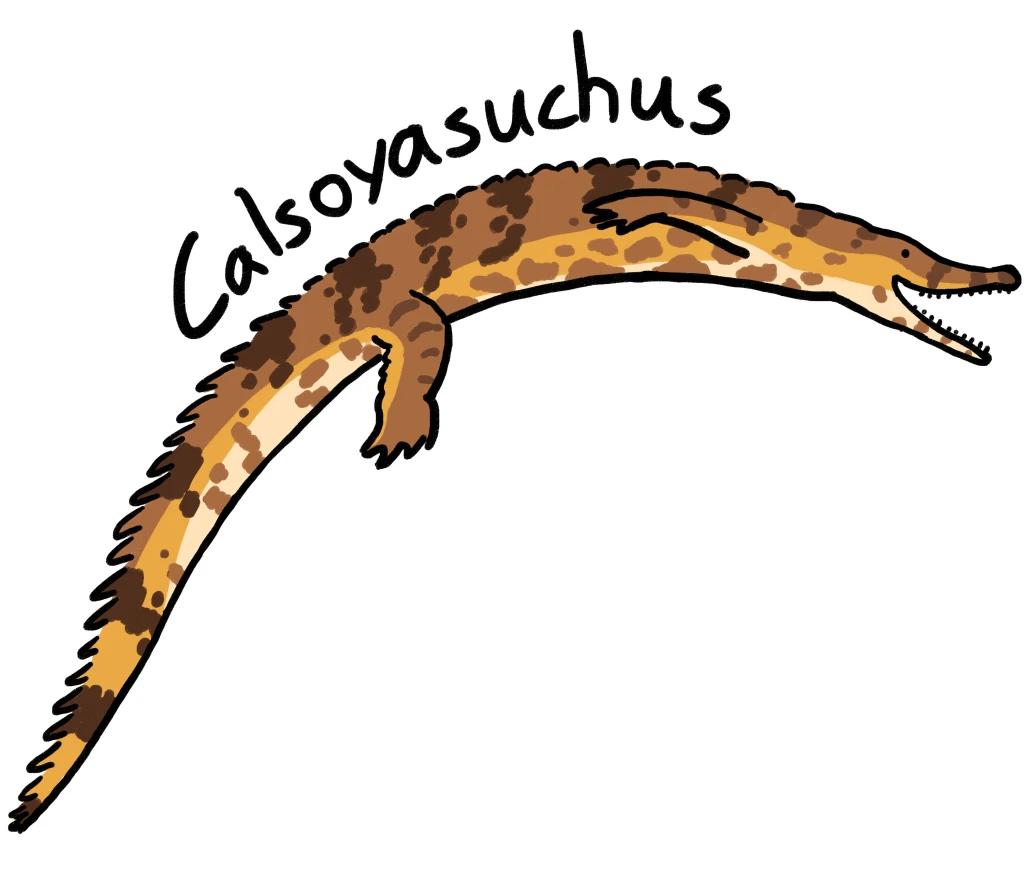
Species: Eopneumatosuchus colberti (Ee-noo-ma-toh-soo-kus kol-brr-tye)
What it means: Pneumatic passage crocodile
Other species: None
Where I live: Arizona in the U.S.A.- The Kayenta formation
When to find me: The Early Jurassic period, about 196 million years ago.
My favorite food: I like fish the best! I’m a pisciivore.

The Kayenta Formation lies along the southern border of a great desert every bit as hostile as today’s Sahara. The transition of habitat from desert to savanna creates an environment called the sahel, or sahelian climate. Only the hardiest of cycads and stunted conifers grow here. 
The floodplain is savanna for most of the year. Drought-hardy ferns and cycadophytes replace the grasses and wildflowers of today. Cycad groves and the occasional hardy conifer dot the wide expanse. In the distance, we see the green of tree ferns, conifers, and ginkgo trees that trace the banks of the rivers that crisscross the plains. In the hot, wet summer, the rivers flood and turn the plains to marshes choked by horsetails. In the winter, the northern desert blasts sand and cool, dry wind for months of no rain. 
Habitat alongside the many rivers that crisscross the otherwise arid landscape. Mud and silt accumulate from seasonal flooding and sands blowing down from the deserts to the north. Horsetails thrive in places where we might imagine grass and cattails. Ferns, cycadoids, and cycads are the “bushes” of the Jurassic. Ginkgo trees and tree ferns stay close to the water.
My neighborhood: The Kayenta formation used to be a tropical floodplain, a bit like African savannah today- but no grass or flowers. Ferns cover the open plains, dotted with islands of spiky cycad groves. Rivers crisscross the land with lush tree ferns, ginkgo trees, and conifers. Every year during the wet season the plains turn into a flooded marsh, but the hottest months bring no rain, and the rivers shrink until the plains are almost as dry as the great desert that lies to the north.
A few of my neighbors: I’m surrounded by big and scary dinosaurs like Dilophosaurus, Coelophysis, and Kayentavenator, so I stay out of their way. Sarahsaurus (an early sauropod) and Scelidosaurus (armored dinosaur) are plant eaters, but also pretty tough neighbors. Little Scutellosaurus (small armored dinosaur) is quite a bit more friendly, and if I’m lucky might even join me for lunch. Mostly I hang close to the river with the frogs, turtles, or fellow crocodile cousins. I’ll often see a long-tailed pterosaur flying overhead for insects like beetles, dragonflies, an ancient cousin of the moth, and something called a snakefly.
Fun Facts:
- I look a bit like a crocodile, but I’m not! You might say we’re distant cousins.
- Even though there are very few fossils, paleontologists still try to make a good guess at who my closest relatives are. At first they thought I was related to a crocodile-ish critter called Protosuchus. But the latest theory is that I’m from a family called Teleosaurs. They’re crocodile-ish critters that look a lot like the modern gharial (think croc, but with a super skinny and long snout), and they specialized in living out on the ocean. Some of them look a bit like crocs trying to play shark.
- My name basically describes the bones that the paleontologists found. Eo (Latin for passage/ “to move along” + pneumaticus (latin for “operated with air pressure”). Describing the part of the skull that was found. The tympanic synuses in a crocodilian are at the very back of the head, almost where the neck connects. Suchus is from the Greek souchos, which is Greek for crocodile, and is pretty common in the names of croc-ish things.
Fossil Finds: A few fragmentary fossils from the back of the skull.
References:
“Eopneumatosuchus.” Wikipedia, https://en.wikipedia.org/wiki/Eopneumatosuchus





